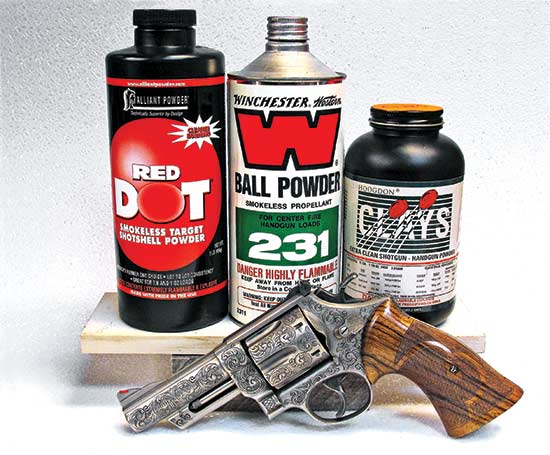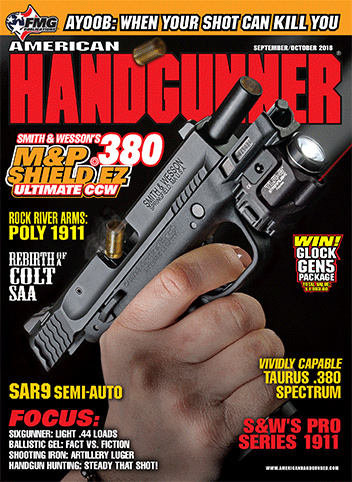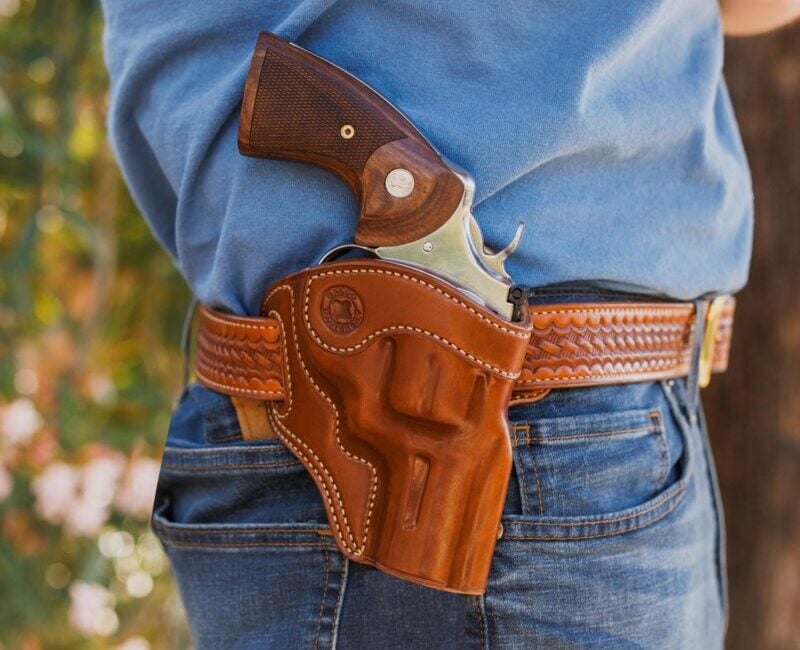Pleasant Shooting Loads
The .44 Magnum
The .44 Magnum arrived in late 1955 with most examples not arriving in gun shops until 1956. At the time Elmer Keith said recoil wasn’t bad and wouldn’t bother “a seasoned sixgun man.” Meanwhile, Major Hatcher of the NRA said shooting it was like getting hit in the hand with a baseball bat. I obviously was not a seasoned sixgun man at the time, being a teen, and I leaned heavily toward Major Hatcher’s assessment when I shot a .44 Magnum for the first time. Keith had spent nearly 30 years shooting his heavy .44 Special loads with a 250-gr. cast bullet at 1,200 fps, so he was better prepared for the .44 Magnum at nearly 1,500 fps. Major Hatcher was not — and neither was I!
The first Ruger .44 Magnum Flat-Top arrived later that year and since it had the grip frame with the same size and shape as the Colt Single Action I assumed felt recoil would be less. In fact, recoil with the Ruger was even worse than the Smith & Wesson. The Ruger rotated straight up and slammed the hammer into the back of the hand. Eventually, I learned to shoot the .44 Magnum in both the Smith & Wesson and Ruger. The answer for the S&W was smooth, custom-made stocks known as Jordan Troopers, by Herrett. These stocks totally enclosed the grip frame, and were without checkering so didn’t irritate the hand. Today, there are much more powerful sixgun loads than the .44 Magnum, however this doesn’t diminish the seriousness of shooting full power .44 Magnum loads. Especially a lot of them!
Versatility
The .44 Magnum is at its best as a hunting sixgun and I’ve used it to take dozens of critters, but moderation in shooting is a key to managing full power loads. Keith said after he had had the .44 Magnum for a year he had shot 600 rounds — total. This averages out to about 12 rounds per week. With the coming of long-range silhouetting many of us shot his yearly supply of .44 Magnum loads in a day or two. We simply were not as smart as he was, I guess?
I still have plenty of heavy Keith loads on hand should they ever be needed, however for everyday shooting pleasure I needed something much different. My goal was to come up with good shooting loads with a muzzle velocity somewhere around 900 fps or less from 71/2″ to 83/8″ sixguns. These are loads which can be shot in comfort, while still retaining a power level even above that of the .45 ACP hardball load, which has a long-established reputation of success.
Whether you regularly shoot full power .44 Magnum loads, or any of the big bores — it takes a lot of concentration to continue to shoot these heavy loads accurately. Yet, we still often fret about the recoil. This isn’t the way to really enjoy shooting sixguns.
I wanted loads still serious under normal circumstances but loads being much more enjoyable in a heavy-framed .44 Magnum. In addition to being comfortable to shoot, my goal was also to come up with accurate, “everyday packin’ loads” which could also be pressed into service for target shooting. Actually at this power level — and carried in a .44 Magnum sixgun with Perfect Packin’ Pistol barrel lengths of 4″ to 51/2″ — they would also serve for self-defense or concealed carry.
Friendlier Loads
There’s more than one way to come up with loads with less recoil. One solution is a lighter bullet such as the 200-gr. RNFP hard cast bullet from Oregon Trail. Another is using powders normally used for less than full house magnum loads. My powders of choice are WW231 and WW452A from Winchester; Alliant’s Unique, Red Dot and Bullseye and Hodgdon’s Universal, Trail Boss and Clays. Hodgdon’s HP-38 is the same as WW231 so they can be used interchangeably.
My bullets of choice are the 200-gr. version as well as the same design in 225- and 240-gr. weights. For something a little more standard for the .44 Magnum I go with Oregon Trail’s 240-gr. SWC. I’ve been using Oregon Trail bullets for more than three decades and I often find they will shoot as well, or in many cases better, than my own carefully cast, sized and lubed bullets.
Over the past 50+ years I’ve added several S&W .44 Magnums, both blue and nickel-plated, as well as the later arriving stainless steel versions, to my collection. Barrel lengths of 4″, 5″, 61/2″, 71/2″ and 83/8″ all have a home here. Thousands of .44 Magnum loads have been run through these beautiful sixguns, but I’ve arrived at the time in my life when shooting a box of full house loads is almost as painful as watching reality TV.
My goal was to come up with loads right at 900 fps or less from an 83/8″ S&W and around 800 fps, certainly not more than 900 fps, from a 4″ gun. I found several loads falling into these categories using 6 grains of powder. Those powders are Red Dot, Unique, WW452AA, WW231, Universal, Trail Boss and Clays. In addition to minimizing felt recoil, I didn’t want to lose accuracy. So, I tested the entire line-up with the new lower powered loads. I called them “Pleasant Shooting Loads.”
Every sixgun, like every sixgunner, has its own distinct personality. A load shooting well in one sixgun may be mediocre in the next. We can only find what is best for our particular sixgun by experimenting. I’d like to point out a few of the most accurate loads I tested. But keep in mind, your results may vary, as they say!
Basic Load Ideas
Many loads were in the category of one inch or less. With the Oregon Trail 240-gr. SWC over 7 grains of Universal one of the 83/8″ Smith & Wesson 29s clocked out at 809 fps with a group of 3/4″ for five shots at 20 yards. Another 83/8″ S&W, this time a Model 629, managed a 5/8″ group with the Oregon Trail 225-RNFP over 6 grains of WW452AA with a muzzle velocity of 906 fps. This same load clocks out at 878 fps from a 6″ Model 629 with the same 5/8″ group. Also in this 6″ Model 629 using the 240-gr. bullet crimped over the front band with 6 grains, Universal clocks out at 872 fps with a 7/8″ group.
Back in the early production of the Model 29 the H.H. Harris Co. of Chicago special ordered 5″ sixguns. I have a pair of these, however they’re not original examples, which are now high dollar collector’s items. I wanted to have a 5″ .44 Magnum so I sent an 83/8″ Model 29-2 to Jim Stroh to have it cut to 5″ and tuned to perfection. While it was gone I got a call from a reader who had somehow found two original barrels in the 5″ length, at the factory. He took one and graciously asked them to put my name on the other as he was sure I would take it.
Thanks to him I sent another Model 29-2 to S&W and it was re-barreled with this original 5″ barrel. The Stroh custom has an exceptional trigger, aiding in accurate shooting. With the Oregon Trail 240-gr. bullet over 6 grains of Clays I get a 3/4″ group at 918 fps. With the same weight RNFP bullet and 6 grains of Red Dot, groups are 7/8″ and the muzzle velocity is 874 fps. I might add here these sixguns with only 1″ more barrel length than the exceptionally easy packin’ 4″ sixguns are nowhere near as portable. One inch more barrel length makes a huge difference. They’re much easier to shoot than the shorter lengths, however there are trade-offs.
The Round Nosed Flat Point bullets are designed for use in the .44-40, however when sized at .429″–.430″ they also do well in the .44 Magnum and .44 Special. They are especially well suited to feeding through the action of a levergun too. They also drop very easily into the sixgun chambers without any hang up, which can sometimes happen with the square driving bands found on 240-gr. SWC bullets. Something to keep in mind.










